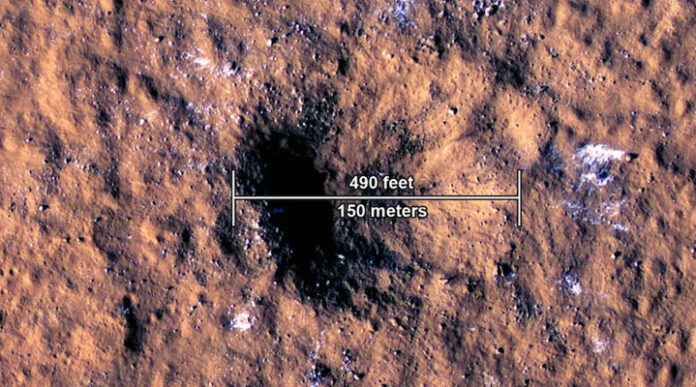The largest meteor strikes and impact craters have been observed by two NASA spacecraft at Mars, one on the surface and the other in orbit.
Scientists revealed Thursday in the journal Science that the high-speed barrages last year cut out craters almost 500 feet (150 meters) in diameter and sent seismic waves rippling thousands of miles across Mars, the first ever detected near the surface of another planet.
The largest of the two strikes churned off boulder-sized slabs of ice, which may aid scientists in their hunt for strategies for future humans to access Mars’ natural riches.
The Mars Reconnaissance Orbiter captured stunning images of the ensuing craters, while the Insight lander monitored the seismic shocks.
The ability to connect the seismic ripples with the crater images was a bonus, according to co-author Liliya Posiolova of Malin Space Science Systems in San Diego. Imaging the craters “would have been massive already.” We were quite fortunate.
In contrast to Earth, where a thick atmosphere prevents most space rocks from reaching the ground and instead causes them to break and burn, Mars has a thin atmosphere.
Using information from the same lander and orbiter, different research last month connected a recent string of smaller Martian meteoroid strikes with smaller craters closer to InSight.
The impact observations occur as InSight approaches the conclusion of its mission due to declining power and dust storms covering its solar panels. InSight, which touched down on Mars’ equatorial plains in 2018, has now counted more than 1,300 marsquakes.
The principal scientist of the InSight lander, Bruce Banerdt of NASA’s Jet Propulsion Laboratory, who participated in the investigations, stated, “It’s going to be heartbreaking when we ultimately lose communication with InSight.” But the information it provided us with will undoubtedly keep us occupied for years to come.
According to Posiolova, the inbound space pebbles ranged in diameter from 16 feet to 40 feet (5 meters to 12 meters). The size of the impacts was roughly 4.
About 2,200 miles (3,500 km) away from InSight, the largest of the two impacted in December, leaving a crater that is about 70 feet (21 meters) deep. The orbiter’s sensors captured images of debris blasted up to 25 miles (40 km) from the impact as well as areas of white ice surrounding the crater, which Posiolova said was the most frozen water ever seen at such low latitudes.
Posiolova discovered the crater in the early months of this year after obtaining additional photos of the area from orbit. She searched through the archives and determined that the crater was missing from earlier photographs, placing the impact around late December. With assistance from that team, she was able to link the new hole to what was clearly a meteoroid strike since she remembered a significant seismic event that had been captured by InSight around that time. It was easy to see the blast wave.
The lander and orbiter cooperated for an earlier meteoroid strike, which was slightly smaller and at a greater distance than the one in December, according to scientists.
“Everyone was completely amazed and shocked. still another? Yes, she remembered.
Seismic signals from the two collisions show that the Martian crust is denser outside of InSight’s range.
Doyeon Kim of the Institute of Geophysics at ETH Zurich in Switzerland, who participated in the study, said that there is still more to learn about the dynamics and internal structure of Mars.
Future Chinese and European landers, according to outside specialists, will be equipped with even more sophisticated seismometers. Future missions will “create a clearer picture” of how Mars evolved, according to an accompanying editorial by Yingjie Yang and Xiaofei Chen from China’s Southern University of Science and Technology in Shenzhen.





